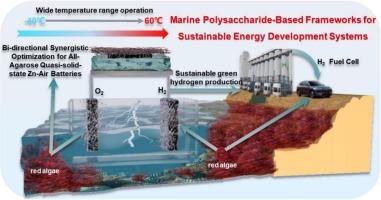Marine polysaccharide-derived multifunctional Fe single-atom catalysts and temperature-tolerant gel electrolyte for sustainable hydrogen production across a wide temperature range
IF 13.2
1区 工程技术
Q1 ENGINEERING, CHEMICAL
引用次数: 0
Abstract
Advanced green hydrogen production systems typically rely on costly catalysts and face operational challenges in off-grid regions and extreme temperature environments. Herein, we propose a dual-purpose material strategy that synchronously converts marine polysaccharides into low-cost tri-functional electrocatalysts and weather-resistant gel electrolytes, enabling decarbonized hydrogen production in remote areas and under harsh temperature conditions. The constructed system demonstrated robust performance across temperatures ranging from −40 °C to 60 °C. A multiscale optimization approach modulates charge density at Fe active sites and metal-support interactions in Fe-based catalysts, achieving trifunctional activity (ORR: E1/2 = 0.90 V; OER/HER: η = 261/172 mV@10 mA cm−2). Concurrently, hydrogen bond engineering transforms electrochemically inert agarose into highly compatible electrochemical interface gel electrolytes, enabling quasi-solid-state Zn-air batteries with extended operational temperature tolerance. This approach eliminates dependence on petroleum-derived materials while achieving carbon-neutral hydrogen production. Our work provides a mild, economical, and sustainable pathway for multidimensional marine biomass utilization and green hydrogen production.

海洋多糖衍生的多功能铁单原子催化剂和耐温凝胶电解质,可在宽温度范围内可持续产氢
先进的绿色制氢系统通常依赖于昂贵的催化剂,并且在离网地区和极端温度环境中面临操作挑战。在此,我们提出了一种双重用途的材料策略,将海洋多糖同步转化为低成本的三功能电催化剂和耐气候的凝胶电解质,使偏远地区和恶劣温度条件下的脱碳氢气生产成为可能。所构建的系统在−40 °C至60 °C的温度范围内表现出稳健的性能。多尺度优化方法调节电荷密度在菲活跃的站点和金属支撑交互Fe-based催化剂,实现三功能性的活动(或:E1/2 = 0.90 V; OER /她:η = 261/172 mV@10 马 厘米−2)。同时,氢键工程将电化学惰性琼脂糖转化为高度兼容的电化学界面凝胶电解质,使准固态锌空气电池具有更大的工作耐温性。这种方法消除了对石油衍生材料的依赖,同时实现了碳中和制氢。我们的工作为多维海洋生物质利用和绿色制氢提供了一条温和、经济、可持续的途径。
本文章由计算机程序翻译,如有差异,请以英文原文为准。
求助全文
约1分钟内获得全文
求助全文
来源期刊

Chemical Engineering Journal
工程技术-工程:化工
CiteScore
21.70
自引率
9.30%
发文量
6781
审稿时长
2.4 months
期刊介绍:
The Chemical Engineering Journal is an international research journal that invites contributions of original and novel fundamental research. It aims to provide an international platform for presenting original fundamental research, interpretative reviews, and discussions on new developments in chemical engineering. The journal welcomes papers that describe novel theory and its practical application, as well as those that demonstrate the transfer of techniques from other disciplines. It also welcomes reports on carefully conducted experimental work that is soundly interpreted. The main focus of the journal is on original and rigorous research results that have broad significance. The Catalysis section within the Chemical Engineering Journal focuses specifically on Experimental and Theoretical studies in the fields of heterogeneous catalysis, molecular catalysis, and biocatalysis. These studies have industrial impact on various sectors such as chemicals, energy, materials, foods, healthcare, and environmental protection.
 求助内容:
求助内容: 应助结果提醒方式:
应助结果提醒方式:


